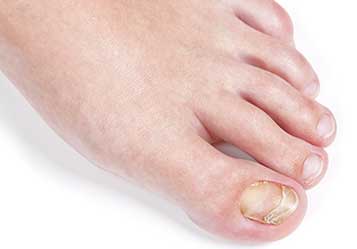
Got Discoloured Toenails and don’t know what it is?
Welcome to the Happy Feet blog, where we prioritise your foot health and well-being. A common concern that many individuals face: discoloured toenails. If you’ve noticed a change in the colour of your toenails, you’re not alone….but what is causing it?
The Mystery of Discoloured Toenails: Causes and Types
- Fungal Infection (Onychomycosis):
– Appearance: Yellowing, white spots, or a brownish discoloration.
– Causes: Fungal infections thrive in warm, moist environments. Tight shoes, communal showers, and trauma to the nail can create an ideal environment for fungal growth.
- Trauma or Injury:
– Appearance: A bruised or discoloured toenail resulting from trauma.
– Causes: Stubbing your toe, dropping something heavy on your foot, or repeated pressure on the toenail such as poor fitting shoes can lead to discoloration.
- Psoriasis or Other Skin Conditions:
– Appearance: Yellow-brown discoloration with pitting or ridges.
– Causes: Underlying skin conditions like psoriasis can affect the toenails.
- Medication Side Effects:
– Appearance:Changes in nail colour due to certain medications.
– Causes: Some medications may cause discoloration of the nails as a side effect.
Fungal Toenails and how to treat
Fungal toenail infections are a common culprit behind discoloration. When fungi invade the nail, it can lead to changes in colour, texture, and thickness. Fungi thrive in warm, moist environments, making the toenails susceptible, especially if there’s an existing injury or damage to the nail.
How to Treat Fungal Toenails: The Laser Advantage at Happy Feet Podiatry
Traditional treatments for fungal toenails include topical antifungal medications and oral medications. However, these methods may have limitations in terms of efficacy and potential side effects.
Enter Laser Treatment:
At Happy Feet Podiatry, we offer state-of-the-art laser treatment for fungal toenails. Here’s why laser therapy is popular:
- Precision Targeting:
– Laser therapy precisely targets the fungal infection without affecting surrounding tissues.
- Non-Invasive:
– Unlike some traditional methods, laser treatment is non-invasive and does not require oral medications.
- Minimal Discomfort:
– The procedure is virtually painless, with most patients experiencing minimal discomfort.
- Speed and Efficiency:
– Laser treatment is a quick procedure, usually taking around 20-30 minutes for both feet.
- No Downtime:
– Patients can resume normal activities immediately after the procedure.
Efficacy of Laser Treatment:
Clinical studies have shown that laser therapy can be effective in treating fungal toenail infections. The laser energy penetrates the nail, targeting and destroying the fungi responsible for the infection. Multiple sessions may be needed for optimal results, and the outcome varies from person to person.
When to Seek Help:
If you notice persistent discoloration of your toenails, especially if accompanied by changes in nail thickness or texture, it’s crucial to seek professional help. A podiatrist can conduct a thorough examination, determine the underlying cause, and recommend appropriate treatment options.
Conclusion:
Discoloured toenails may be a common concern, but with the right diagnosis and treatment, you can restore the health and appearance of your nails. If you suspect a fungal toenail infection, consider the advanced laser treatment options available at Happy Feet Podiatry. Our experienced podiatrists are here to guide you on your journey to healthier, happier feet. Don’t let toenail discoloration hold you back – take that step towards treatment and reclaim your confidence.
Visit our dedicated laser page for more info laser nail technologies
